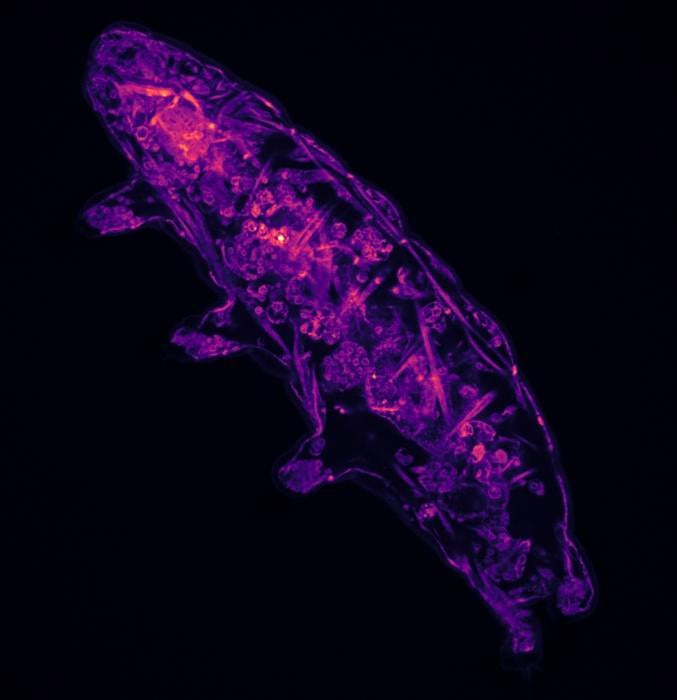Tardigrades are some of the toughest animals on the planet. These microscopic creatures commonly called “water bears” can survive in environments with extreme temperatures, without water or oxygen. Scientists may have pinpointed the precise molecular mechanism the tiny invertebrates use to put up with such intense conditions. They have a molecular sensor that detects uninhabitable elements of their environment, and tells them when to go dormant and when to resume their normal activities. The findings are described in a study published January 17 in the open-access journal PLOS ONE.
[Related: Tardigrades go where the slime takes them.]
What is a tardigrade?
There are more than 1,100 species of tardigrade. These free-living invertebrates are considered close relatives of arthropods. They are about 0.04 inch or less in size and live in a variety of habitats. They are found on flowering plants, in moss, sand, fresh water, and the ocean.
Most plant-eating tardigrades pierce individual plant cells with their stylets and suck out the cell’s contents for sustenance. Some are predatory carnivores that eat other small invertebrates.
German zoologist J.A.E. Goeze saw tardigrades through a microscope in 1773 and recorded that its body looked like a shriveled and shrunken version of a bear. He named it kleiner Wasserbär, or German for “little water bear.”
How do they survive extreme environments?
When faced with dry, barren, and otherwise inhospitable environments, tardigrades go dormant and enter a tun state. Their eight legs retract, their bodies become dehydrated, and their metabolism slows down so much that it is almost undetectable. They curl up into a ball. They can remain in this state for years. Previously, scientists weren’t sure what signals water bears to enter or leave their death-like state where they don’t require nutrients.
In this new study, researchers exposed the tardigrades to temperatures of -112 degrees Fahrenheit or high levels of hydrogen peroxide, salt, or sugar to trigger dormancy in a lab. Their cells produced damaging oxygen free radicals in response to these harmful conditions. The free radicals will react with other molecules, but they will also oxidize an amino acid called cysteine. It is one of the building blocks of proteins in the body and the reactions make the proteins change their function and structure, and signal the water bear to go into its dormant state. The cysteine allows them to feel out their environments and react to stressors.

When the conditions improve and the free radicals are gone, the sensor is no longer oxidized. The tardigrades then remerge from their dormancy. The team also applied chemicals that block cysteine to their environment and found that the water bears couldn’t detect the free radicals and did not go dormant.
According to the team, these results show that cysteine is a key sensor for switching dormancy on and off in response to multiple stressors. It suggests that cysteine oxidation is a vital mechanism that water bears use to help them survive in constantly changing environments.
[Related: We’ve seen how tardigrades walk, and it’s mesmerizing.]
“Our work reveals that tardigrade survival to stress conditions is dependent on reversible cysteine oxidation, through which reactive oxygen species serve as a sensor to enable tardigrades to respond to external changes,” the authors wrote in a statement.
Can this help humans?
Future studies into this mechanism could determine if this happens across all tardigrade species. Since free radicals may be linked to age-related ailments, more studies of tardigrades could help scientists better understand aging.
“Whether this is a universally conserved protection mechanism and whether this is conserved across tardigrade species are really important questions,” study co-author Leslie Hicks from the University of North Carolina at Chapel Hill told New Scientist. The answers may help us better understand the aging process and even how to achieve long-term space travel, she says.





